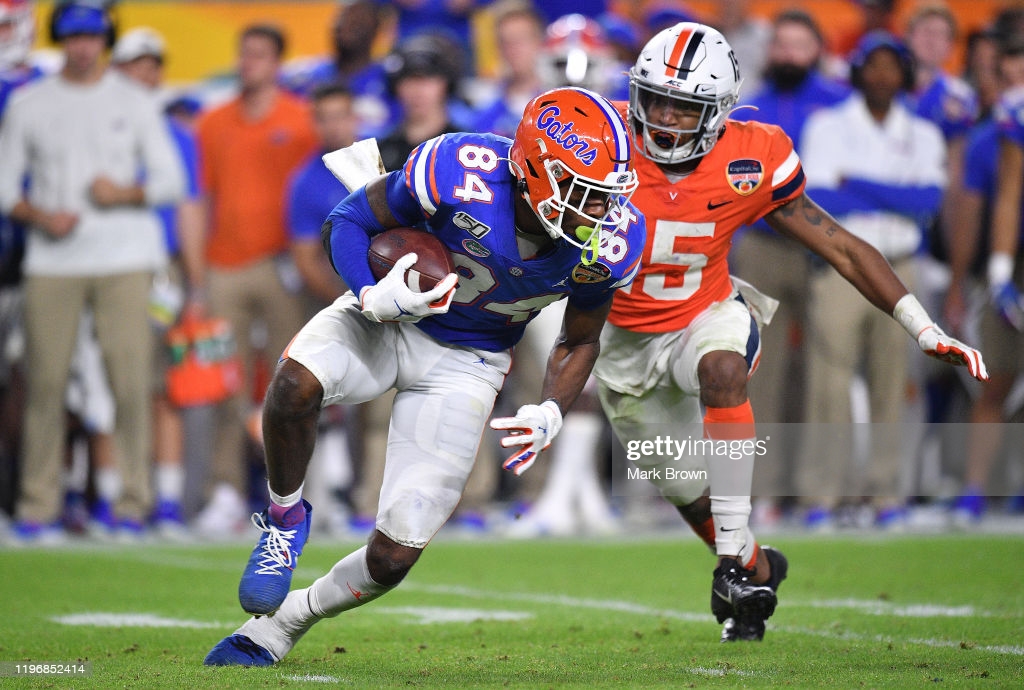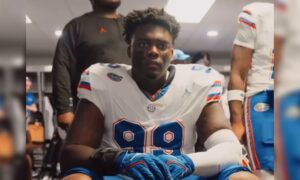From now until the 2021 NFL Draft takes place, we hope to showcase as many prospects as possible and examine both their strengths and weaknesses. Most of these profiles will feature individuals that the Pittsburgh Steelers are likely to have an interest in, while a few others will be top-ranked players. If there is a player you would like us to analyze, let us know in the comments below.
#84 Kyle Pitts / TE Florida – 6’6” 246
The Good
- Great size, solid build. Elite athlete for the tight end position
- Versatile, mismatch type of player. Can line up out wide, in the slot, as an H-back, and in-line. Gives creativity to how his coaches can utilize him to attack defenses. Also makes it harder for defensive coordinators to scheme ways to stop him when he’s constantly being moved around
- Great route runner for his size. Good balance, solid quickness and speed. Able to win with technique (hands at the line and footwork), physicality, and leaping ability
- Strong hands, hands catcher. Never dropped a red zone pass at Florida according to PFF (31 targets). Able to win jump balls with physicality and leaping ability (tough to match when he’s already 6’6”). Tracks the ball well, able to high point it, great body control in the air. Elite catch radius
- Willing blocker. Displayed a solid foundation in 2020 that can be worked on in the NFL
- Just 20 years old (born October 6, 2000)
The Bad
- Inconsistent blocker. Displayed improvement in 2020 but can work to improve his fundamentals (his stance/base and hand placement) which will create consistency. Has to ensure he maintains the mindset to engage with blocks from a fundamental standpoint every rep (would like to see a greater sense of urgency at times). Seemed to lack the necessary strength to take on bigger defenders and even some similar in size
- Wasn’t able to secure a few contested catches due to concentration (it seemed like he was already thinking about what he was going to do after the catch before securing the pass) or a hit from a blind spot
- His play strength as a receiver is great. Defenses need a specific type of player with the combination of size, speed, strength, and athleticism to defend him one on one. However, adding some weight to his frame might serve to aid his ability as a blocker. It really depends on what team drafts him and how they plan on using him in their offense. Like I stated in the first bullet point, he seemed to lack play strength when blocking in-line at times. Adding weight to his frame plus improving his fundamentals would help
Bio
- 2020 Stats (8 games): 43 receptions, 770 yards, 17.9 yards per reception, 12 touchdowns
- Career Stats (24 games): 100 receptions, 1,492 yards, 14.9 yards per reception, 18 touchdowns
- 2020 John Mackey Award Winner
- 2020 Fred Biletnikoff Award Finalist
- 2020 Walter Camp Player of the Year Semifinalist
- 2020 CFPA Tight End Trophy Winner
- Top-10 in Heisman Trophy voting for 2020
- Unanimous All-American first team selection in 2020
- Coaches’ All SEC first team selection in 2020
- Coaches’ All SEC first team selection in 2019
- 2019 Walter Camp Player of the Year Semifinalist
Tape Breakdown
In my January profile on Pat Freiermuth, I touched upon why the Pittsburgh Steelers’ could consider addressing the tight end position in the upcoming 2021 NFL Draft. Alex Kozora expands upon why the Steelers should address the position at some point in the 2021 NFL Draft here.
While Freiermuth leans more toward the playstyle of a traditional tight end (he’s a sure-handed option in the short to intermediate passing game and is also (in my opinion) a better blocker than Pitts at this point in their careers), Kyle Pitts is the modern-day NFL’s definition of a weapon. Standing at 6’6” and weighing 246 pounds, Pitts is a wide receiver playing in a tight end’s body. He can be referred to as a “Joker” tight end, a term commonly associated with dynamic tight ends who do most of their damage in the passing game. Pitts isn’t the best blocker at this stage of his career, but I also don’t think he’s bad either. He has shown the desire to learn and improve, and if he continues to do so in the NFL, he will pose an even scarier threat to defenses.
Back in January, Dave Bryan provided a detailed contextualization of Pitts’ 2020 targets.
In the report Bryan noted that of the plays he charted (64 plays), Pitts had an average depth of target sitting at 13.6 yards, and an average air yards per reception of 12.1 yards on his 43 catches. That is extremely impressive for a tight end, and it goes to show how Pitts is a menace for defenses in all areas of the field. He isn’t the fastest tight end ever (he’s not slow either), but he can win with his size, strength, leaping ability, route running, and with his hands in contested catch situations. He can stretch the field vertically while also being able to work the short to intermediate areas as a security outlet for his quarterback. Kyle Pitts is a walking mismatch.
Let’s get right into the good. This first clip is from the 2020 SEC Championship featuring both Florida and Alabama. Kyle Pitts is lined up at the top of the screen against one of the best cornerback prospects in the 2021 NFL Draft pool, Patrick Surtain II.
Surtain is lined up in Pitts’ face but opts against using a jam which gives Pitts free reign over what he can do with his route. Pitts begins his release by shuffling his feet towards the sideline indicating an intent to break outside, but he then shimmies and bursts inside to open space. Since Surtain never got his hands on, Pitts is able to eye his quarterback without any resistance until he receives a low throw that he scoops into his chest and secures for a first down.
This is an NFL-level competitor that Pitts is able to beat. Regardless of who is defending him, they will have to be meticulous with their plan of attack or Pitts will find a way to win.
Another clip from the same game vs. Alabama displays Pitts coming down with a fantastic grab in the end zone. He’s lined up in the slot boundary side. With just over two minutes remaining in the game and Florida needing a quick score, quarterback Kyle Trask drops a beautiful pass over two Alabama defenders for Pitts to high point. These 50/50 balls are the type of throws that his NFL quarterback will be able to feel somewhat comfortable with (when he probably shouldn’t), due to the sole fact that there aren’t many defenders who will be able to jump with Pitts. His combination of size, strength, leaping ability, and strong hands make him a red zone nightmare for defenses, and he will be his quarterback’s security blanket in the NFL as well.
This next clip is from the Gators’ 2020 matchup with Kentucky. Pitts begins the play in-line and shoots forward vertically at the snap. As he gets on the toes of the defender, he angles his route outside with a head fake to sell an outside break which forces the defender to turn his hips. Pitts then utilizes a “crossover” move with a hard jab of his left leg, which is a type of basketball move that his teammate Kadarius Toney often used as well.
After shooting back inside with his defender beat, Pitts quickly locates the pass, then it’s off to the races where he shows some solid speed to reach the end zone for six.
This clip is a play from Florida’s game against South Carolina in 2020. Kyle Pitts displays his strength, insane catch radius, and sticky hands. He is lined up in-line on the boundary side of the field, and after the snap he has a free release up the seam where he’s then met by a waiting defender. Pitts gives a little hesitation stutter towards the outside before fighting through the hands of the defender to the inside. He then has to quickly locate the ball as it’s already being released by quarterback Kyle Trask. He gets his eyes on the ball then leaps into the air to grab it with both hands. He finishes the play by dragging the defender forward for some extra yards.
This clip is from Florida’s first game in their 2020 season against Ole Miss. Kyle Pitts is lined up as the single receiver on the boundary side of the field and has a cornerback defending him. This play is a clear example of Pitts as a mismatch. He is both quick and fast enough to beat smaller defenders out wide or in the slot while also being bigger and stronger than them.
On this play specifically, Pitts opts for an outside release, to which he then fights back inside through the hands of the defender. To do so he utilizes strength that the defender just can’t match. After securing inside leverage, Pitts gets his head around to track the ball and is able to hop in order to secure the pass that was placed over top of the defender he just beat. He moves the chains with little time remaining in the half and is also targeted again on the next play of the game, which shows that he’s a guy who his QB looks at (and will look at in the NFL) in key situations.
It’s a difficult task for defenses to find a defender with the size, strength, and athleticism to match up with Pitts when he’s moved around the formation.
Kyle Pitts is a monster in the passing game, that’s for sure. Now let’s take a look at his blocking.
Being a capable blocker is necessary for any Pittsburgh Steelers tight end. In order to become a capable blocker at the tight end position, a prospect first needs to show a willingness to block. A willing blocker can be molded into a serviceable and possibly even a good to great blocker. While Pitts can and should continue to improve his blocking from a fundamental standpoint (which will in turn create consistency), he is a willing blocker. This is a massive positive, because as the saying goes; “you can lead a horse to water, but you can’t make it drink.”
In this clip from Florida’s 2020 game vs. South Carolina, Kyle Pitts motions from the tight bunch set over to the left side of the field. At the snap, he rockets forwards and engages with the defender. He gets low, maintains his balance, and keeps his hands glued to the chest of the defender as he absorbs the push and stands his ground before driving the defender backwards. This rep shows Pitts has the mentality that is needed to be a capable blocker, even if his play strength isn’t always there. In the NFL, he will be able to build upon what he showed in his 2020 season, which was a desire to get involved in both the run game and pass protection.
This clip is from Florida’s 2020 matchup with Missouri. It displays another solid rep from Pitts. He’s in-line boundary side and is blocking play side on the designed QB run. At the snap, Pitts drives forward and moves the defender who’s slanting inside, thus maintaining the integrity of the hole for the pulling left guard and quarterback Kyle Trask to scamper through untouched. Pitts gets low to keep better leverage than the defender while engaging with his arms and driving his feet until he accomplishes his assignment.
This clip from Pitts’ game against Ole Miss again displays Pitts’ willingness to block seen in his 2020 season. He is lined up off the line and stays home to help in pass protection. As the ball is snapped, he gets his head up and scans for any threats as he maintains a fundamentally sound base. When he sees that no defenders are attacking his vicinity, he finds work. He chips the closest defender he sees, assisting his teammate (the right tackle) on the play. This rep doesn’t look like much and didn’t impact the outcome of the play, but Pitts displays that he takes pride in his work and wants to ensure he does his job regardless of what’s asked of him. While Pitts will be sent out on routes more often than he’s asked to assist in pass protection in the NFL, it’s great to see him show this desire. At the NFL level, the best blocking tight ends never take plays off.
Overall, these types of reps give a glimpse at Pitts’ promise as an in-line blocker, and there were also times in his college career where he was used as a blocker and successfully aided a play on a screen, as a puller at the second/third level, or when moving laterally behind the line of scrimmage. Pitts isn’t the best of the 2021 tight end prospects when it comes to blocking, but to say he is a complete liability would be selling him short. He has shown progression and a desire to continue improving, which is what you want to see from a prospect if you’re an NFL franchise about to invest early-round draft capital on him due to his skillset as a receiver.
Now to the bad, which has to be discussed. To get a peek at how Pitts developed as a blocker from 2019 to 2020, I watched Florida’s 2019 game vs. LSU. While he did have some solid reps blocking in the game, I also noticed a couple where you could see his raw/unrefined fundamentals.
On this play, Pitts begins by shuffling towards the right tackle because he is trying to avoid giving the defender an opening to slice through the C gap. However, the defender sees this and shoots past him to the outside D gap. Pitts doesn’t move his feet back towards the defender or get solid engagement with his hands, which forces him to dive in order to ensure he pushes the defender away from quarterback Kyle Trask. It’s also important to note that the defender Pitts is blocking is a safety, not an edge rusher. While Pitts wasn’t completely beaten, he didn’t convincingly win the matchup either.
Pitts showed he can handle one on one situations with defenders in 2020, but he will have to continue to improve his fundamentals in order for his coaches to consistently rely upon him.
Moving on, this clip displays another example of Pitts’ inconsistency as a blocker, which can be seen even in his most recent season (2020). This play is from Florida’s matchup with Ole Miss. Pitts is lined up off of the line as an H-back and is pulling to the play side of the run. He’s looking to seal the defender off to the outside with a kick-out block in order to create a gap for the ball carrier to run through. Pitts does not display proper fundamentals on this play, however. As he is about to engage with the defender, he dives at him lethargically with his right shoulder. The defender easily avoids the attempt and is able to move inside where he would have been able to make a play on the running QB had his teammates not already wrapped him up.
While Pitts has progressed as a blocker over the course of his college career (as seen in the earlier clips from his 2020 season), he can still work on refining his technique and striving towards a repetitious mindset, which will make him more consistent overall. Hopefully the improvements Pitts put on tape in 2020 are a sign of things to come and show a foundation that his NFL coaches will be able to work with. If the Steelers were to draft Kyle Pitts in 2021, then blocking would become a necessary piece of his future success, making further improvement a must, and his most dire area to focus on.
Pitts will likely be gone before the Steelers’ #24 overall draft pick however, meaning if the team wants him, they will have to trade up to get him. Personally, I don’t see this happening due to the fact that the Steelers are rarely that aggressive in the draft, and if they were to trade up it would most likely be for who they would believe to be a future franchise quarterback.
The NFL team that ultimately drafts Pitts will have a new offensive mismatch that will leave defensive coordinators scratching their heads. He may not be the best all-around tight end prospect at this point in his career, but his receiving prowess mixed with the blocking potential that he flashed in 2020 will make him a very likely first round selection.
Projection: Early to Mid-First Round
Games Watched: LSU (2019), Ole Miss (2020), South Carolina (2020), Texas A&M (2020), Missouri (2020), Georgia (2020), Kentucky (2020), Tennessee (2020), Alabama (2020)








